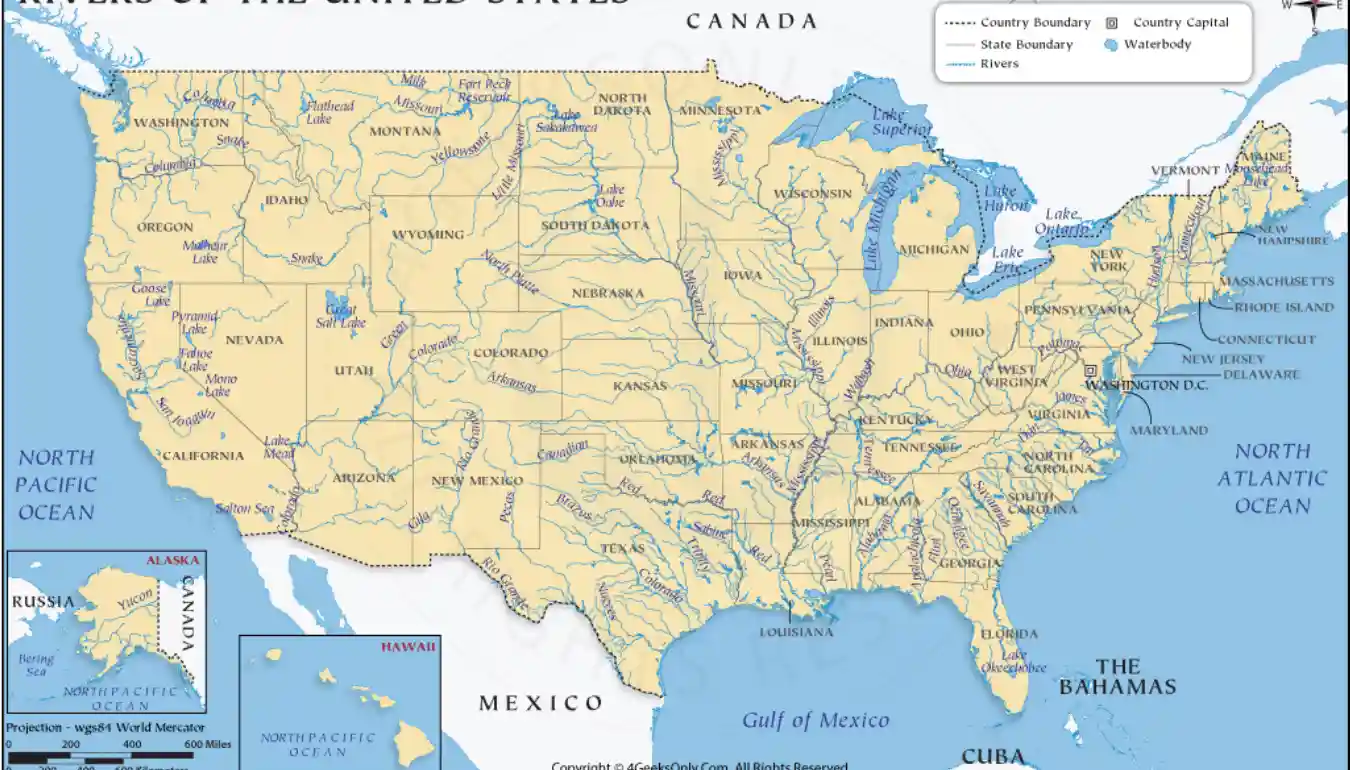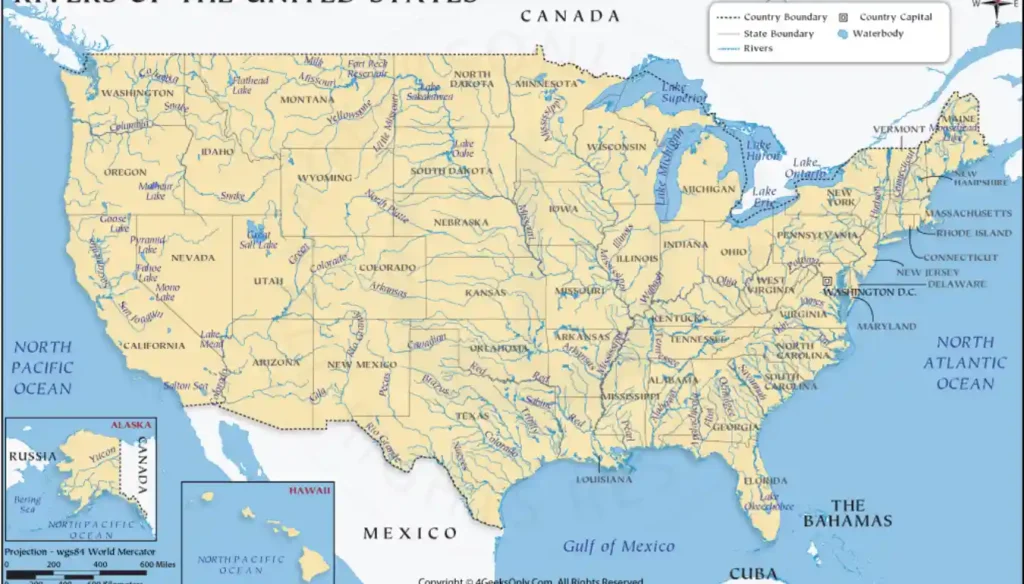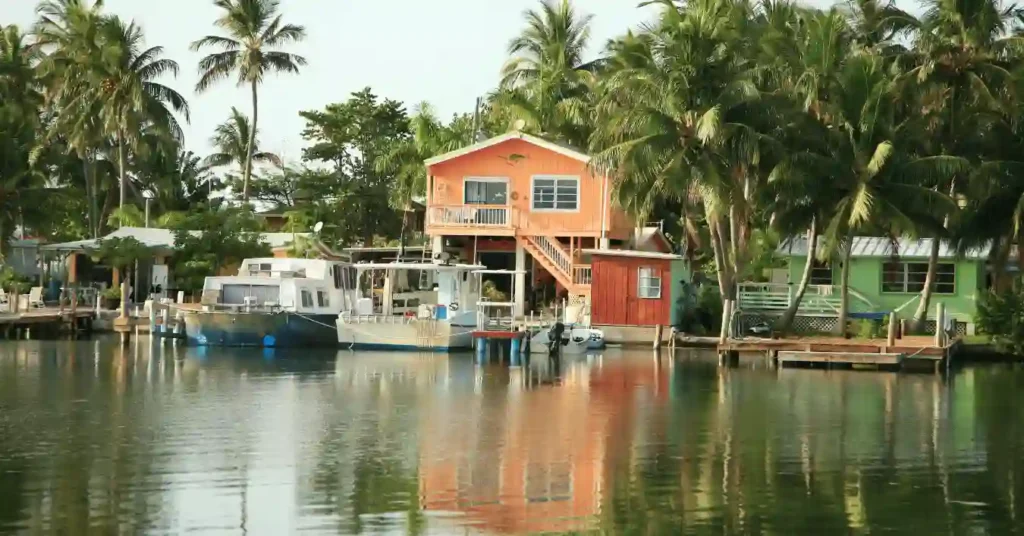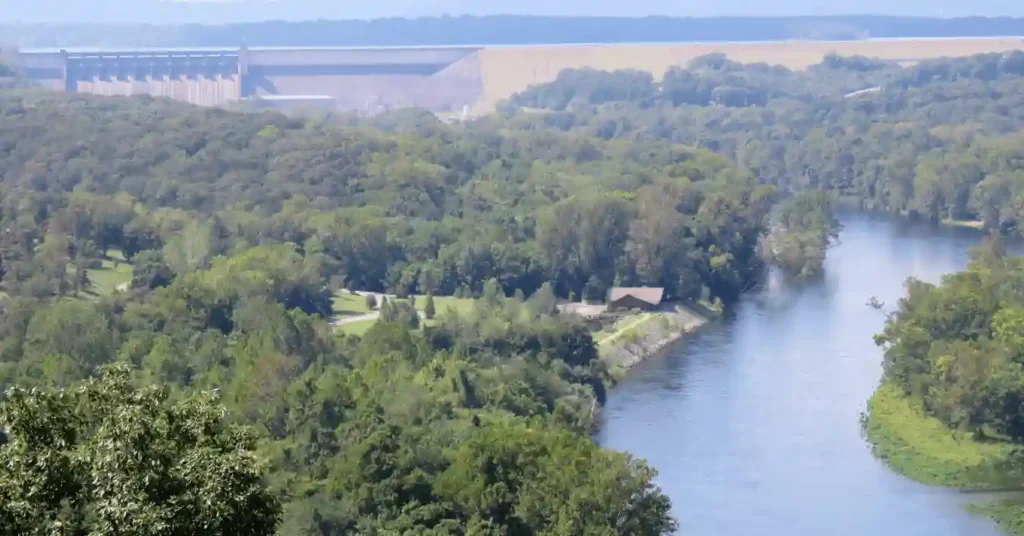Fly Fishing Setup for Trout For Beginners | Expert Guide

As I explore the calm world of fly fishing for trout, I’ve found something that is a must – having the right gear isn’t just helpful; it’s super important for catching fish.
From sharing stories by the peaceful river bends to the exciting moments when a fish tugs on the line, I’ve learned that having the proper fly fishing gear for trout is key.
In my journey to get better at trout fishing, I’ve realized that having the right tools not only makes fishing more fun but also makes a big difference.
So, let’s dive in together through the misty mornings and beautiful sunsets that color our fishing trips, and find out about the tools that mix skill with art in the quest for the perfect catch.
Through my 16 years of experience i will provide all the essential information for the fly fishing setup for trout. Moreover, in this guide, we will discuss the best equipment for trout fishing, tips and tricks and much more.
Key Takeaways
- A good fly fishing setup for trout can significantly influence catch rates.
- Understanding the components of trout fishing gear leads to a more effective angling approach.
- The knowledge of fly fishing for trout essentials equips anglers for various fishing scenarios.
- Personal experiences validate the importance of selecting the right gear for targeted species.
Fly Fishing Setup for Trout: A Step-by-Step Guide
Starting your trout fishing adventure with the right beginner fly fishing gear is really important. I’ll guide you through each step to help you get ready for success in the water.
The rod, reel, and line weight all work together in a special way, like a dance between you and the fish. Let’s dive in and learn how to set yourself up for a great fishing experience!
Selecting the Appropriate Line Weight
Understanding the significance of line weight is vital. It’s the linchpin that connects your skill to the water’s soul. Selecting the right line weight isn’t just about preference—it’s about the species of trout you’re after and the peculiarities of the river or stream you’re fishing.
The key is to balance sensitivity and strength, offering a line that can register a trout’s subtle bite yet withstand its vibrant fight. A line that’s too heavy can spook the fish; too light, and you might lose your catch.
Setting Up Your Backing, Line, and Leader
Let’s break down the foundational aspects of a fly fishing setup for trout. Starting with the backing, it’s your insurance policy—the extra line that comes into play when a trout decides to take a long run.
Next, attaching your fly line is all about precision and ensuring a seamless flow through your rod’s guides. Lastly, connecting a leader with the right delicacy allows your flies to move naturally in the current, tempting even the wariest of trout.
| Component | Description | Importance |
|---|---|---|
| Backing | Durable, thin line placed before the fly line | Provides extra line for long-running fish |
| Fly Line | Weighted line designed for casting flies | Allows for precise casting and fly delivery |
| Leader | Clear, monofilament line that connects fly line to fly | Ensures natural fly presentation |
| Tippet | Thin line tied between the leader and the fly | Provides flexibility and stealth |
You can learn More Tips And Tricks from the following Dirt Hook.
Choosing the Right Trout Fishing Rod and Reel Combo
The pursuit of trout means gearing up with the proper equipment, especially when it comes to the cornerstone of your angling arsenal: the trout fishing rod and reel combo.

Whether you’re contemplating the serenity of a mountain stream or strategizing for success in a sprawling lake, the appropriate setup can make all the difference. I’ve explored rivers and streams, lakes and ponds.
Through this diverse experience, I’ve refined my approach to selecting a recommended trout fishing setup that harmonizes with your fishing style and the aquatic environment you’re delving into.
Understanding Rod Length and Action
When selecting a fishing rod, two key characteristics to consider are length and action. While a shorter rod can provide greater precision on small streams, a longer rod enables improved casting distance on open lakes.
The action of the rod, ranging from slow to fast, influences not only your casting dynamics but also your sensitivity to fish bites.
For the best fly fishing gear for trout, I favor a medium-action rod, which offers versatility and a good balance between power for casting and finesse for presenting the fly delicately.
Comparing Spinning vs. Fly Reels for Trout
Distinguishing between spinning and fly reels is crucial for tailoring your trout fishing rod and reel combo. Spinning reels are renowned for their ease of use, making them a superb option for beginners.
However, for those drawn to the art of fly fishing, investing in a quality fly reel enhances the ability to present flies in the most lifelike manner and offers unparalleled control. In my excursions, fly reels have provided that immersive, hands-on experience that truly elevates trout angling.
Recommended Combos for Beginners and Avid Anglers
For those just starting their fly fishing journey, I recommend a beginner-friendly trout fishing rod and reel combo such as the Orvis Clearwater setup. It offers a forgiving learning curve with reliable performance.
Seasoned anglers may gravitate towards more specialized combos, such as the Sage X matched with a Galvan Torque reel. This pairing falls within the realm of the best fly fishing gear for trout, crafted for precision and Durability amidst varying conditions.
Trust me, matching the right rod and reel can amplify your fishing experience and success rate with every cast
Recommended: How To Fish Emergers For Trout
Top Rated Fly Fishing Gear for Trout
As an avid angler, I’m always on the hunt for top-rated fly fishing gear for trout that can withstand the rigors of the sport while elevating my fishing experience.
Today, I’ll share with you the trout fishing equipment that has not only received high ratings but has proven its worth on the waters time and again.
The world of trout fishing gear is vast, but selecting the right equipment is paramount. Factors like innovative design and Durability play a major role in performance and customer satisfaction.
Let’s look at some standout performers in the trout fishing landscape
- Trout Rods: The market boasts rods that promise sensitivity and strength, perfect for those delicate trout bites and vigorous battles.
- Reels: Smooth drag and reliability are non-negotiable when it comes to reels. I’ve found a few that maintain performance even after repeated dunkings in those mountain streams.
- Fly Lines: A good fly line is like a trusted confidant—it’s there to convey your strategy directly to the trout with finesse and precision.
- Waders: To stay dry and comfortable during long hours of pursuit, top-notch waders are a must-have, and I’ll reveal the brands that have kept me dry season after season.
- Accessories: From nippers to tippets, high-quality accessories are the secret weapons in an angler’s arsenal.
Seasoned fishermen and novices alike understand that having reliable trout fishing equipment is crucial for success. Quality gear not only enhances your ability to catch trout but also ensures a more enjoyable and productive time on the water.
Note: the following table contains affliate link to Amazon.
| Equipment Type | Brand/Model | Features | Why It Stands Out |
|---|---|---|---|
| Rod | Orvis Helios 3D | Fast action, precision casting | Exceptional accuracy and power for diverse fishing conditions |
| Reel | Ross Reels Animas | Sealed drag system, lightweight | Durability and smoothness in a sleek design |
| Fly Line | Rio Avid Series | Built-in slickness, versatile taper | Perfect for all-around trout fishing with improved line control |
| Waders | BASSDASH Walker Breathable Warder | Breathable, puncture-resistant | Optimal comfort and resilience in rugged environments |
| Accessories | Fishpond San Juan Vertical Chest Pack | Integration system for tools, adjustable strap | Keeps essential tools within reach for quick and efficient use |
Now, let’s reveal some of the highly recommended gear that has been put to the test by fellow anglers and me.
The Vital Role of Flies in Trout Fishing Success
As someone deeply passionate about fly fishing, I can attest that the flies you choose are as critical as any high-tech piece of trout fishing gear. It’s not just about having a robust fly fishing setup for trout; it’s about knowing how to lure them to your line.
Let’s dive into the types of flies and their strategic uses in various fishing scenarios.
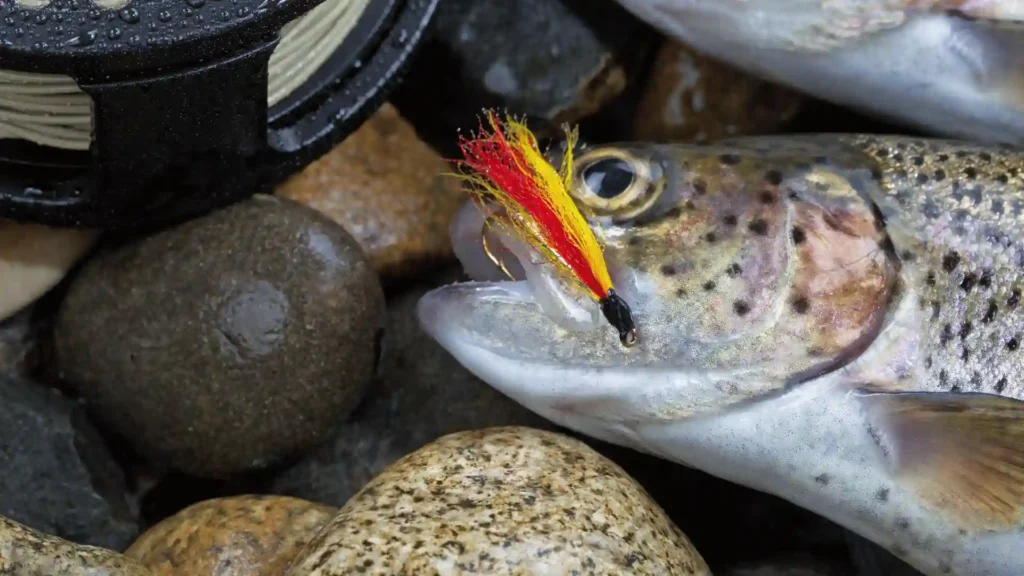
Dry Flies, Wet Flies, Nymphs, and Streamers
Each type of fly serves a unique purpose in mimicking the natural prey of trout. Dry flies are designed to float on the water’s surface, perfect for when trout are looking to snatch insects above.
Wet flies, in contrast, sink beneath the surface, imitating submerged insects or larvae. When trout feed on insects in the middle to bottom of the water column, nymphs come into play, closely resembling insect larvae and pupae.
Lastly, streamers are the go-to for mimicking small fish and can trigger aggressive strikes from larger trout.
| Fly Type | Water Layer | Trout Feeding Behavior | Common Species Represented |
|---|---|---|---|
| Dry Flies | Surface | Surface feeding, rising trout | Mayflies, Caddisflies |
| Wet Flies | Subsurface | Sub-surface feeding | Emerging nymphs, drowned adult insects |
| Nymphs | Mid to bottom | Bottom feeding, during non-hatch periods | Stonefly nymphs, Caddis larvae |
| Streamers | Varies with retrieval | Aggressive towards other fish | Minnows, leeches |
Choosing the Right Fly for the Conditions
The concept of matching the hatch is a cornerstone in selecting the optimal fly. This means observing the types of insects currently being eaten by trout and then choosing a fly that resembles these insects as closely as possible.
Factors such as the season, weather conditions, and time of day can influence which types of insects are present.
Therefore, having a varied collection of flies in your arsenal is crucial, ensuring you’re prepared for any situation you may encounter on the water.
- Spring: A time for mayflies and caddis; dry flies and nymphs are quite effective.
- Summer: Terrestrials like grasshoppers or ants are prevalent, making larger dry flies a wise choice.
- Fall: Streams are often full of fallen leaves; thus, nymphs and streamers can yield good results.
- Winter: Midges dominate, necessitating smaller flies and delicate presentations.
By mastering the selection and application of these flies, you will certainly enhance your fly fishing setup for trout and stand a better chance at successful catches, regardless of the conditions.
Remember, the right trout fishing gear is not just about rods and reels; it’s about understanding and imitating the prey that trout cannot resist.
The Art of Casting: Technique Tips for Trout Fishing
Fly fishing for trout is a graceful sport, finely tuned by the angler’s ability to cast effectively. Over the years, I’ve honed my casting technique, a journey filled with snags and triumphs.
As you gather your fly fishing setup for trout, it’s essential to master the cast. In this piece, I’m excited to impart tips that address common hurdles and teach you how to navigate them so your trout fishing tackle isn’t just about the gear but also about the skill.
Casting Tip #1: The Overhead Cast
The bread and butter of fly fishing casts, the overhead or forward cast, is where everyone starts. It’s crucial to keep your wrist firm, using your forearm to direct the motion.
Flexibility in the wrist can lead to a whip-like action, which might sound cool, but it messes up your line’s trajectory. Your aim is to create a tight loop in your line for a precise, controlled distance.
Casting Tip #2: The Roll Cast
The roll cast is your best friend when you’re up against an obstacle that makes a back cast impossible. The key to a successful roll cast is to slowly raise the rod tip vertically, with your line dangling in front and slightly beside you.
Then, in one swift move, bring the rod forward, stopping sharply around eye level. It casts the line straight out onto the water. It requires less space than the overhead cast and is perfect for those tight trout streams.
Casting Tip #3: Mending
After your successful cast, mending is critical for managing your line in currents. Proper mending prevents unnatural drag on your flies, making your presentation more appealing to trout.
Lift and flip your rod tip gently, repositioning the line in a controlled manner while maintaining minimal disturbance on the water’s surface.
Practice Makes Perfect
Remember, the essence of achieving a perfect cast lies in constant practice. There’s no substitute for time on the water. Experiment with different casting styles and learn them like the back of your hand.
It will dramatically improve your competence with trout fishing tackle and your overall fly-fishing setup for trout.
| Technique | Description | Benefits |
|---|---|---|
| Overhead Cast | Standard cast using a back and forth motion to build up energy in the rod before releasing the line forward. | Good for distance and accuracy, foundational for most casting techniques. |
| Roll Cast | A cast performed by rolling the line out in front of you without a back cast, good for tight spaces. | Ideal for fishing in confined areas with limited room for a back cast. |
| Mending | Technique of repositioning the lne on the water after casting to manage currents and achieve a natural drift. | Allows for a more natural fly presentation, increasing the chances of a trout bite. |
Maintaining and Caring for Your Trout Fishing Equipment
There’s a certain pride that comes with owning quality trout fishing equipment. However, to ensure that it serves you well for many fishing seasons, it’s important to adopt a routine of proper care and maintenance.
Not only does this help in preserving the function and appearance of your fly fishing gear, especially for beginners who have just invested in their first setup, but it also saves you time and money in the long run by avoiding unnecessary repairs or replacements.
Cleaning and Storing Your Fly Rod and Reel
To keep your fly rod and reel in top condition, start by disassembling the rod, wiping down each section with a soft cloth to remove any debris or dirt. The reel deserves the same attention, with a gentle rinse in fresh water to clear out any residues from fishing in saltwater or muddy environments.
Make sure all components are thoroughly dry before storage to prevent corrosion of metal parts or damage to the rod’s finish.
Tip: Store your rod horizontally in a cool, dry place to maintain its shape. Use a rod tube for added protection and organize reels in a padded case to prevent any knocks or scratches.
Wader Care and Storage Solutions
Your waders are your first line of defense against the elements, and proper care will ensure they remain waterproof and comfortable. After each use, rinse your waders to remove any sediment, and hang them upside down to dry completely before storing.
Check for and repair any punctures or tears to prevent leaks on your next trip.
Storage advice: Avoid folding your waders, which can create creases and weaken the fabric. Instead, hang them in a cool, dry place, away from direct sunlight and heat sources that may degrade the materials.
Effective Use of Fly Fishing Vests and Packs
Fly fishing vests and packs are game-changers for keeping your trout fishing equipment organized and readily accessible. For beginners, a vest with multiple pockets might be beneficial, holding everything from tippet spools to snack bars.
More experienced anglers might opt for a sling pack, which offers greater mobility without sacrificing storage capacity. The best part about these storage solutions is that they distribute weight evenly, ensuring you can move freely and focus on the fishing at hand.
| Fishing Net Types | Features | Best For |
|---|---|---|
| Rubberized Mesh Net | Non-absorbent, Fish friendly | Catch and Release |
| Telescopic Handle Net | Extendable for extra reach | Bank Fishing |
| Folding Net | Collapsible, Space Efficient | Backcountry Angling |
Trout Fishing Tackle: From Hooks to Sinkers
When I’m preparing my fly fishing setup for trout, I always pay close attention to the array of smaller items that constitute my trout fishing tackle. It’s the little things—hooks, sinkers, and a myriad of other accessories—that can make a significant difference in any trout fishing scenario.
So, let’s break down these essentials and discover how each component can enhance your fishing experience.
- Hooks: The foundation of any good fishing tackle, hooks come in various sizes and shapes. For trout, I prefer using smaller hooks as they tend to be more discreet and are less likely to spook the fish.
- Sinkers: Adding just the right amount of weight to your line, sinkers help achieve the perfect depth and maintain the right drift in the current. Split shot sinkers are particularly handy as they can be easily adjusted on the line.
- Strike Indicators: Essential for nymph fishing, strike indicators alert you to the subtlest of bites. A well-placed indicator can be the difference between catching that elusive trout or not.
| Item | Description | Use Case |
|---|---|---|
| Barbless Hooks | These hooks are easier to remove and better for catch-and-release. | Ideal for conservation-focused areas where trout populations are managed for sustainability. |
| Tungsten Sinkers | Denser than lead, they get your flies down quicker without adding too much bulk. | Perfect when fishing deeper pools or faster streams where trout may be lurking at the bottom. |
| Foam Indicators | Light and highly visible, they make detecting strikes easier without spooking fish. | Use these in calmer waters where subtlety is key, especially effective for clear water sight fishing. |
Understanding Trout Behavior for Better Fishing Outcomes
Achieving success in fly fishing for trout is not just about having the best trout fishing gear on hand; it’s also heavily reliant on understanding the intricate behavior of trout.
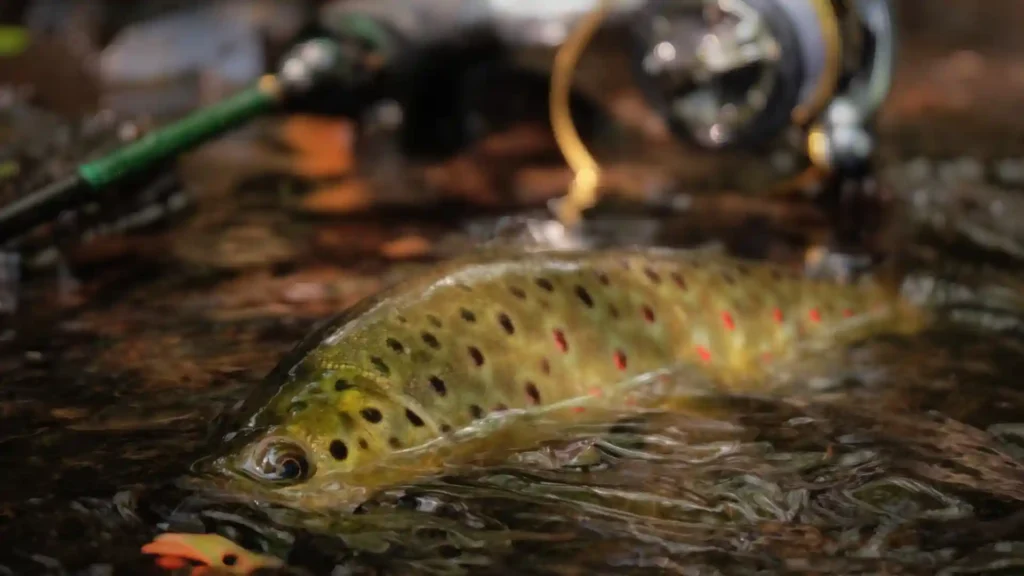
Through years of angling experience and countless hours observing these fish in their natural habitat, I’ve come to appreciate the nuances that can make all the difference between a day of fruitless casts and a triumphant catch.
Let’s delve into the feeding patterns and seasonal migrations of trout, as well as tips for reading the water to locate prime trout holding spots—a vital part of assembling your fly fishing for trout essentials.
Recommended: Best States for Fly Fishing in USA
Final Words
Fly fishing for trout is a graceful sport, finely tuned by the angler’s ability to cast effectively. Over the years, I’ve honed my casting technique, a journey filled with snags and triumphs.
Throughout this guide, we’ve journeyed together through the essentials of assembling a fly fishing setup for trout. From discussing the best rod and reel combinations to embracing the intricate world of flies, I’ve shared with you the elements that can bolster your chances of a successful catch.
Reflecting on the insights provided, the crucial lesson is clear: having meticulously chosen trout fishing gear tailored to your needs as an angler can significantly enhance your experience on the water.
As we part ways, remember that evolving your skills and your best fly fishing gear for trout is a continuous process.
In the stillness of the river, listening to the rhythmic cast and the gentle splash of trout beneath the surface, you’ll find not just a hobby but a form of personal growth and deep satisfaction.
I encourage you always to keep learning and perfecting your craft, just as I will continue to do, in our shared passion for fly fishing.
As you go forward, casting line after line, let’s pledge to maintain the unspoken bond of respect we have with nature. Practice sustainable fishing, catch and release with care, and contribute to the preservation of our pristine waterways for generations to follow.
This journey isn’t just about catching trout; it’s about the stories we create, the tranquility we foster, and the legacy we leave—tight lines and serene waters to you, my fellow angler.
What is the importance of the correct fly fishing setup for trout?
The correct fly fishing setup is important for trout fishing because it affects the presentation of the fly, the accuracy of the cast, and the ability to effectively hook and land fish.
How do I choose the best trout fishing rod and reel combo?
Consider the following factors when choosing a trout fishing rod and reel combo:
Rod length: Opt for a shorter rod (5 to 7 feet) for better control and accuracy in trout fishing.
Power and action: Choose a light or ultralight rod with fast or medium-fast action to detect subtle bites and improve sensitivity.
Rod material: Graphite rods are lightweight and offer excellent sensitivity for trout fishing.
Reel type: Spinning reels are popular for trout fishing due to their versatility and ease of use.
Gear ratio: Look for a reel with a moderate gear ratio (5:1 or 6:1) for a good balance between power and speed.
Drag system: Ensure the reel has a smooth and reliable drag system to handle the runs and jumps of trout.
Line capacity: Consider the line capacity of the reel based on the average size of trout in your fishing area.
Budget: Determine your budget and find a combo that offers good quality within your price range.
Remember to consider your personal preferences, fishing technique, and the specific waters you’ll be fishing in when choosing a trout fishing rod and reel combo.
What are the steps to set up my fly fishing gear as a beginner?
To set up your fly fishing gear, start by selecting the appropriate line weight for the trout you are targeting and the water you’ll be fishing. You’ll then attach the backing to the reel, followed by the fly line.
Next, you’ll connect the leader to the fly line, ensuring proper knot strength and Durability. Finally, select and tie on your fly according to the trout species and hatch conditions.
Can you recommend some top-rated fly fishing gear for trout?
Some of the top-rated fly fishing gear for trout include brands like Orvis, Sage, and Simms, known for their high-quality rods and reels. A popular choice is the Orvis Clearwater setup, which offers great value and performance.
In terms of waders and boots, Simms offers reliable options that are favored among experienced anglers for their Durability and comfort.
What role do flies play in trout fishing?
Flies are the critical lure in fly fishing and significantly impact your success in catching trout. They are designed to mimic the natural insects and aquatic creatures that trout feed on.
By “matching the hatch,” or choosing a fly that resembles the current food sources in the water, you can entice trout to bite. The different types of flies—such as dry flies, wet flies, nymphs, and streamers—serve various purposes and are chosen based on fishing conditions and trout behavior.
How does cang technique affect trout fishing?
Your casting technique is vital in fly fishing as it determines the accuracy, distance, and delicacy of your fly presentation. Poor technique can lead to spooking the trout or missing a potential catch due to inaccurate placement.
Mastering the art of casting allows you to strategically place your fly where trout are feeding, increasing your chances of a successful catch.
How does understanding trout behavior improve my fishing outcomes?
Understanding trout behavior is key to knowing where and when to fish for them. Recognizing their feeding patterns, seasonal preferences, and holding spots in the water enables you to choose the right fly, determine the best time to fish, and cast in locations where trout are likely to be active.
This knowledge allows you to feel more strategically and effectively with your trout fishing gear.

Meet Ibrahim Khan, an avid angler and author in Fishing Teach. He shares his wealth of knowledge from his 16 years of experiences in fishing. His articles are a captivating blend of practical insights and thrilling tales that invite readers into the enchanting world of fishing.
Ibrahim’s guides are your go-to guide in the realm of fishing on this informational site. Hailing from a coastal paradise, Ibrahim’s passion for angling is the heartbeat of his life.

